‘Red Guitar’ was the first song heard from Brilliant Trees, being the advance single heralding Sylvian’s debut album. But when we carefully removed the vinyl from its designer inner-sleeve for the inaugural play of a Sylvian solo LP, it was ‘Pulling Punches’ that launched the ride into the unknown. And what an explosive, energetic opener it is.
It’s easy to focus on the otherworldly ambient textures of side B when reflecting on this album; Jon Hassell’s trumpet to the fore, combining with fellow Stockhausen alumnus, Holger Czukay. Certainly Sylvian emphasised the second side of the vinyl as the direction in which he was drawing his listeners. However, it would be wrong to assume that there was any less care taken in the creation of the earlier, more traditionally song-based, tracks nor in the selection of precisely the right musical partners to bring these compositions to life.
The up-tempo start signals immediately that whilst Japan the band might now be departed, Steve Jansen’s singular drumming style would be integral to the sound stage for the immediate future. Before Sylvian has sung a note we are also introduced to two new partners, the funk bass of Wayne Braithwaite (more often spelled Brathwaite) injecting vitality and power as the chords from Ronny Drayton’s guitar glide above. Japan had often embraced funk, most recently in the superb single cut of ‘The Art of Parties’, released in April 1981 before a re-recorded version appeared on Tin Drum later that year. The riffing guitars and punctuating horns of the single version have some parallels with Sylvian’s opening statement on Brilliant Trees.
In Cries and Whispers, Anthony Reynolds’ volume capturing a decade of post-Japan experiences of the band’s former members, he references rumours that Mark King of Level 42 was initially considered for bass duties on the song, with David Grant of Linx approached for backing vocals – albeit it’s also recorded that the latter has no recollection of being asked. In the end, Sylvian went close to the core, to New York City, and enlisted Braithwaite and Drayton. For a flavour of the music that Wayne Braithwaite was making at the time, check out his vibrant riff for the introduction to Melba Moore’s ‘Mind Up Tonight’ from her 1982 album The Other Side of the Rainbow. It’s a record on which Ronny Drayton also appears, albeit not on the same tracks as Braithwaite. The same was true of the eponymous debut album by American singer and producer Kashif the following year. Drayton would later say of the guitar and bass partnership for Brilliant Trees, ‘David put us together and it just worked.’ (2010)
The left-handed Drayton was notable for having learnt on borrowed right-handed instruments, keeping them strung as they would be for their intended users. So, the bass strings to the bottom of the fretboard with the higher ones above. This pickles my amateur guitar player brain, as every chord shape and scale pattern just literally got turned upside down. Just how did he do it, and so naturally?
Sadly, neither Wayne Braithwaite nor Ronny Drayton remain with us, the bass player passing in 1991 when in his early 30s, and the guitarist as recently as 2020. In an extensive interview for the Everyone Loves Guitar podcast in 2019, Drayton was full of energy and expectation for the future. When asked by the host to look back over his career and name his top three studio experiences, remarkably – given his extensive recording history across decades – Ronny chose to recall his part in Brilliant Trees…
‘I had a manager, his name was Bruce Wallis, and I was playing with Nona Hendryx…We did this festival down in Atlanta, and I went down with Nona and we played, and I remember hanging out with Janet Jackson, talking to her, she was really young…But I remember sitting down and I got a [message] from Bruce, he said, “Listen Ronny, can you call me.” I didn’t have a cell phone then… yes, I’ll step out. He said, “call me collect it’s important.”’ When they connected, Bruce explained, “I just got a call from this guy named David Sylvian.” ‘I said, “who’s David Sylvian?” “He played in a band called Japan.” I said, “Really?! David Sylvian?!”
‘All my friends that I grew up with, like five friends – all guitar players – were listening to all the exotic music from everywhere. One friend of mine in particular, Craig, we used to use his house as the cutting room to learn all these records. I was the guy who could learn the records fast…So, Craig used to have all these records by Japan – import all these different records – so I knew about the music of Japan, which we really dug a lot, because we were listening to all this English stuff, all this experimental sh*t. We were loving this sh*t! We were really odd-ball kind of guys, trust me. You’re in the black neighbourhood, all South Jamaica, Queens [NYC]…dressed crazy, the whole nine. It’s like The Man Who Fell to Earth with Bowie, that was me!
‘So I got the call, I was in Atlanta, he said, “When you come home, what guitars do you have?” I said, “I have my old strat that Eddie Kramer [Jimi Hendrix’s engineer] gave me…and I have some pedals and stuff and blah, blah, blah blah.” He said, “David asked specifically for a certain sound that you have. They have some old Marshalls in Germany, we want to make sure that you can do it…You can fly home. You have about a six hour or seven-hour window, and we’re going to fly you to Berlin.”
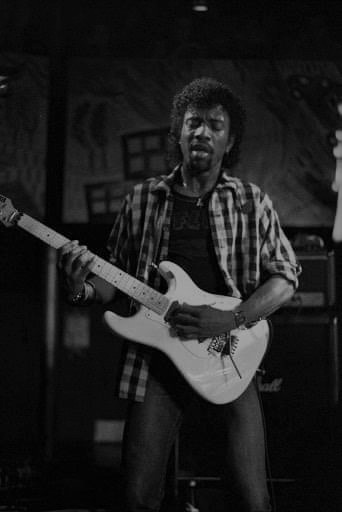
‘So they flew me to Berlin. I put some extra pedals in this little lunchbox [pedal board]…and the old Japanese pedals, ‘cause the old Japanese pedals by Boss sound much better than the newer ones…So, I got my suitcase, packed some clothes, said hello to my grandmother, got in a taxi, went back to Kennedy airport, flew to Berlin. They flew me to Berlin to Hansa Tonstudio where Bowie did Heroes!
‘So now I’m in Berlin, I’m living in this facility, which I thought was crazy, because we were right on the [West/East Berlin] border at the time because the borders were still up. So, I walk into the studio, and Ryuichi Sakamoto’s in the room, myself, Wayne Braithwaite, who’s gone now – great bass player, producer – and the whole “Japan crew”. So as soon as I walk in the room, everyone’s like, “oh man, you played on this record, tell me how you did this, did you play on that record with Scritti Politti (I played on the Scritti Politti sh*t) and did you do this…and Kashif?” And the English guys are going nuts.
‘David’s just sitting there. He goes, “Ronny listen, if you don’t want to play anything today you don’t have to. We can get sounds and all the rest.” So, I go into the room, I had set the pedal board up in the room, and there was this beautiful old Marshall. I think it was a 50 or 100, man. I just plugged straight into the thing… the thing sounded like sex.
‘I turned the thing on, and I remember just standing there with my mouth open, watching all these guys in the control room looking at me with a smile on their face. The tech had this smile on his face ’cause he knew I was going to freak out.
‘So when I started dialling sounds in, I didn’t realise that they were recording the whole time I was in there doing it. So I’m in there playing parts…and playing little funky stuff I know, opening up and playing some stuff, whammy bar crazy, just going nuts, testing where the feedback is, where I can move a note, [that] I can move the feedback round like I wanted to, and they were going, “Oh Wow!”’
A stand-out recollection relates to those chords first heard in the introduction of the opening track of Brilliant Trees above the engine of Jansen and Braithwaite. ‘Later on, when I came back and cut the track called ‘Pulling Punches’, I was playing these rhythm chords, which is a sound you hear now that’s in every pedal board in the world, this kind of like 11 chord, but the way it sounds… it has this sound on it where they put this sheen on it, a little chorusing and this delay, so it sounds like ‘Shalaaaaang’ – you hear this on the track. When you listen to it, you’ll hear it. Wayne’s killing this, playing this bass part.’
It’s fun to listen to ‘Pulling Punches’ following the lead guitar lines; in my mind’s eye I can see Ronnie unleashed at Hansa, especially during the solo at around 1 min 40seconds – I don’t remember it being that wild!
Shortly after this article was first published, David Sylvian commented on twitter, ‘Ronny’s account of our day together in Berlin rings true. There’s musicians who’re born showmen, Ronny was one. When he realised he wasn’t just free to go wild but encouraged to do so, he didn’t hold back. It was an entire performance for those assembled. He was on fire.’ (2021)
Then, incredibly after so many years, Sylvian shared online some video footage of the Brilliant Trees sessions in Berlin shot by Yuka Fujii. All at once, Ronny’s recollections are brought alive on screen:
The film also serves as a reminder of the technical issues that were encountered at Hansa. ‘We were given the basement to work in although the drums were recorded in the large room. The basement had terrible grounding issues as you can hear before Ronny’s opening chord. Hence when it came to ‘Brilliant Trees’ we had to relocate Holger to the courtyard’ (DS, 2021). (See here for more on that anecdote).
Steve Jansen recorded his drums ‘in the massive room at Hansa by the Wall’ and would point to a specific aspect of the drum pattern which contributes to both its drive and vibe. ‘‘Pulling Punches’: when you make a decision to place the first snare beat between the one and two it calls for commitment in terms of arrangement. That push drives the track and with the guitars and brass complementing it works well. If I imagine the snare on beat two, the track would fall rather flat’ (2016). Give it a listen with this in mind and you’ll hear exactly what he means.
Just as he had done in the Japan days, Jansen kept detailed notes of the sessions. It was on 16 August 1983, he recalls, that ‘Wayne and I perform ‘…Punches’ together. I played to a click-track and Wayne pushed the tempo a bit hard, so after getting a good drum take he masterfully dubbed bass in the control room.’ (2021)
Right from the outset Holger Czukay works his magic, injecting the unexpected with his armoury of office dictaphone and tapes. ‘On ‘Pulling Punches’, Sylvian recalled, ‘there are a lot of brass things played on the dictaphone which just happened. We ran through the track and he played the tape, and they all fell into the places they are on the finished piece. That kind of thing is an improvisation of tape which I’d never heard of before I worked with Holger.’ (1986)

Journalist Karl Lippegaus, who would later feature on Sylvian & Czukay’s Plight and Premonition, reported in the German magazine Spex Music that producer Steve Nye was unsure at first what to make of Holger’s improvised interventions, with Holger himself not knowing whether he was going too far. The situation was quickly resolved. ‘As Holger shouted from the studio into the control room during overdubs on ‘Pulling Punches’, “Steve! It’s too much, shall I leave it for a while?” Mr. Nye’s head nearly slammed through the screen: “Nooo Holger! We like that!!!” The bubble burst, and everybody laughed.’ (1984)
Czukay is credited with both samples and french horn on the track credits. The two undoubtedly overlap, with some of the samples being of his own playing. Listening to the album Snake Charmer, released the year before Brilliant Trees by Jah Wobble with Holger Czukay and U2’s The Edge, it’s possible to hear some very familiar phrases on the track ‘It’s a Camel’. Take a listen to an excerpt here:
Sylvian cited ‘Pulling Punches’ in a number of 1980s interviews when asked why so little aggression shows through in his work. Doesn’t he ever just want to explode?
‘Yeah. But it’s not within my nature. I sometimes want to produce music that is just energy, rather than the atmospherics upon which most of my music is based. I tried to do that on ‘Pulling Punches’, which can only be related to from a purely energy point. It’s something I’d like to do more of, a music that comes from an explosion of frustration rather than from a quietly methodical way of working. I don’t know how capable I am of it, which is why I tried it with that track.’ (1984)
Once the follow-up Gone to Earth had been released, Sylvian drew a parallel between the Fripp-fuelled onslaught of that album’s title track and the energy of the opener on Brilliant Trees.
Some have said that the ‘Pulling Punches’ barely belongs on Brilliant Trees, labelling it a sop to Japan fans to encourage their engagement in the story beyond the band. That’s surely too dismissive. The track seems to be an important starting point, and by the time the title cut fades gracefully from view at the end of side B, the boisterous beginning has been displaced by another vibe completely. This progression is one of the beautiful things about the album to these ears, with the opening song a cultured piece of pop and well worthy of its place in the running order.
There’s a thematic symmetry too. The album’s opening lines pose a question, picking up from where ‘Forbidden Colours’ left off (for more on that, see here):
‘If heaven watches over me
Sowing seeds back in the soil
With eyes that see, hands that feel
Why am I the last to know?’
Can there be a nurturing presence above, enriching our lives? By the record’s end there is still no certainty of a benevolent oversight from heaven, but more acceptance of a life on earth – ‘the soil’ – where the wonder of divine love can be found in human experience:
‘My whole world stands in front of me
By the look in your eyes
By the look in your eyes
My whole life stretches in front of me
Reaching up like a flower
Leading my life back to the soil’
So what was the catalyst for the frustration that pours out in ‘Pulling Punches’? ‘The desire to understand, then a kind of anger at the inability to understand, the idea that if you’re living your life and think you know what you’re doing, you’re sleeping on your feet, you’ve got no idea, you’re not in control. That comes out in anger and frustration sometimes, which is just what ‘Pulling Punches’ is.’ (DS, 1986)
‘Sheltered lives spent partially breathing
Are gathered together under new religion
Pulling punches, sleeping on our feet
Pulling punches, I needed someone to comfort me’
There’s an evident disregard for the answers offered in his religious searching beyond the Christian religion of a British school education. ‘‘New religion’ would be a reference to the hybrids that surfaced with the advent of the New Age movement. Belief systems that had gone through something of a filtering process removing all the fat and therefore any potential benefit. A religion that by default’s pulled its punches,’ Sylvian later explained, giving his definition of religion as, ‘a set of beliefs, practices, and disciplines based on a defined set of human and spiritual values, informed by the wisdom of its literature as recorded by its prophets.’ (2003)
‘Sleeping on our feet’ is most likely the first reference in Sylvian’s lyrics to the concepts of philosopher and mystic George Gurdjieff. According to the Russian most people sleepwalk their way through life, reacting to what happens around us according to habits and how we have been conditioned. To live a full life, we need to wake up and free ourselves from that conditioning:
‘In order to awaken, first of all one must realise that one is in a state of sleep. And in order to realise that one is indeed in a state of sleep, one must recognise and fully understand the nature of the forces which operate to keep one in the state of sleep, or hypnosis…One thing alone is certain, that man’s slavery grows and increases. Man is becoming a willing slave. He no longer needs chains. He begins to grow fond of his slavery, to be proud of it. And this is the most terrible thing that can happen…’
It was an idea that would remain with Sylvian well into the future, including the track ‘Sleepwalkers’ over a quarter of a century later.
Sylvian’s explorations into literature are evidenced across Brilliant Trees:
‘A better world lies in front of me
A sketch of life in the books I read’
Here we have a specific reference to Jean-Paul Sartre’s existentialist novel Nausea. In that book, Roquentin’s sense of ‘sweet sickness’ is heightened by inanimate objects around him – such as trees – which impinge upon his ability to define himself, creating doubt about the nature of his own existence.
‘Nature feeds this nausea
Deep inside the heart of me’
‘Existence everywhere, infinitely, in excess, for ever and everywhere; existence—which is limited only by existence. I sank down on the bench, stupefied, stunned by this profusion of beings without origin: everywhere blossomings, hatchings out, my ears buzzed with existence, my very flesh throbbed and opened, abandoned itself to the universal burgeoning. It was repugnant. But why, I thought, why so many existences, since they all look alike? What good are so many duplicates of trees?’
Jean-Paul Sartre, from Nausea
Sylvian’s lyric is perhaps ambiguous as to whether nature is heightening the sense of uneasiness and isolation or acting as an antidote. This album’s title and its defining final track bear witness that splendour of nature wins through as a supremely positive force, enhancing human life. (See ‘Brilliant Trees’.)
‘Pulling Punches’ would be the third single release from the LP in October 1984. ‘Red Guitar’ and ‘The Ink in the Well’ were promoted with videos directed by Anton Corbijn which stand artfully out of time. However, the promo created for ‘Pulling Punches’ is much more rooted in typical ’80s offerings, with production tricks like the animation of pencil sketches and unsophisticated caricature paintings blended with shots of the singer performing the number. The most enjoyable aspect is a series of arresting straight-to-camera shots of Sylvian. Maybe the video colours some people’s view of the music itself and makes that feel dated by association?
The producer of the video in unknown. Sylvian said a few years later that he couldn’t remember who had taken the lead but bemoaned as a ‘real problem…the alternatives Virgin would come up with at the nth hour.’ The ‘Pulling Punches’ promo was, he said, an example of an unhelpful approach from the record company. ‘They’d often request a video be delivered to their desks within two or three days of the initial call. A rush job based on initial sales of a particular single (we tried to pre-empt this approach on many occasions but to no avail). They’d supply directors, producers, who’d scramble to pull something together within the minimal budgets and inadequate time frames.’ (2002)
The packaging for the single was a much more tasteful affair, with a white embossed 7″ single cover and portrait on black for the 12″. There could be no mistaking that the principal influence on the artwork was the French writer, visual artist and film-maker, Jean Cocteau. The handwritten text on the 12″ is consistent with how the album had been personalised, but the presence of the five-point star between the track title and artist name shows it was also a nod to how Cocteau would sign his works. The press advert sported a pencil-line drawing of a trumpet, an echo of the guitar sketch that loomed behind Sylvian on the ‘Red Guitar’ cover, both clearly presented in Cocteau’s style.
Early copies of the single came with a set of three postcards, photographs by Yuka Fujii, and here the Cocteau influence continues to be explicit. In one, Sylvian holds up a ceramic by the artist, ‘Les Trois-Yeux’, reputedly Picasso’s favourite amongst his works.
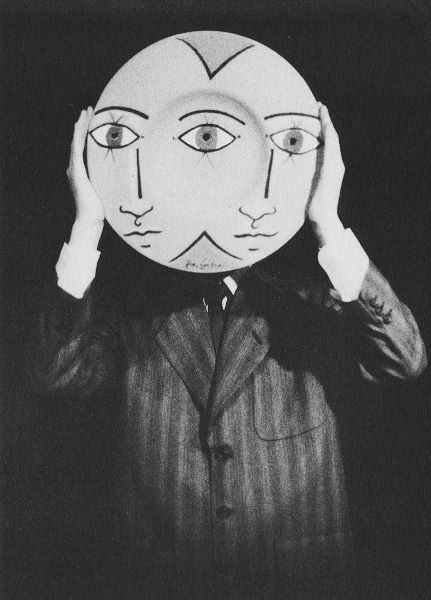
Below we see Jean Cocteau pictured with his creation when it was first revealed in 1958, produced in a numbered edition of 50.
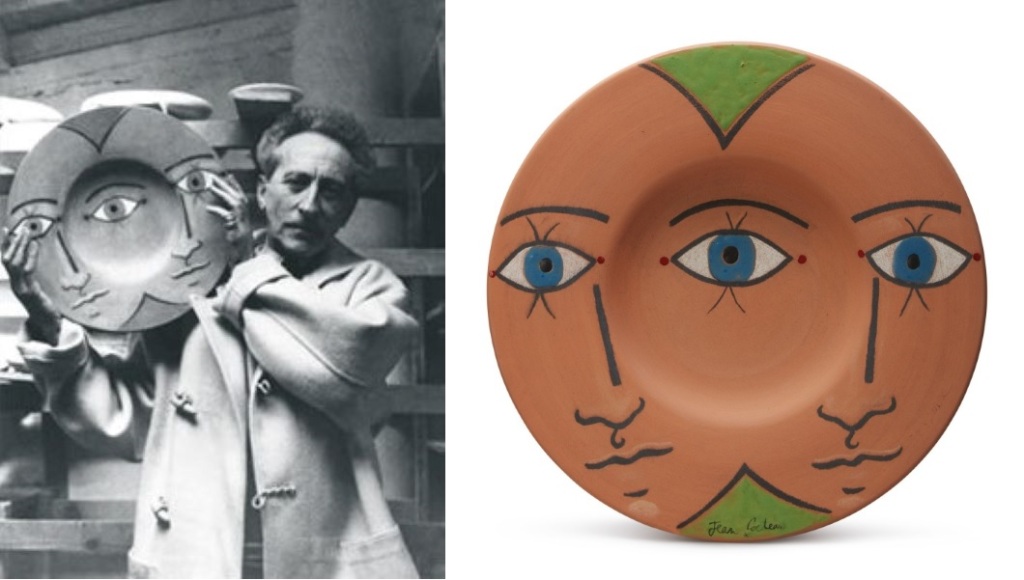
The horse pictured alongside Sylvian in the second shot is a jointed model allowing its legs to be moved and neck flexed into various poses, presumably as an artist’s model.

This too has a Cocteau connection, the stills below being from a 1960 film in which Frenchman speaks of life as a poet and traces his development as an artist from a young man to one now entering his seventies.

The final postcard is part photograph, part sketch. It was a device that Cocteau himself had used and comparing the drawing technique adopted by Sylvian with the artist’s 1939 self-portrait, the stylisation is clear. Note the five-point star alongside the signature, ‘Jean’, and also featured in Sylvian’s hair.
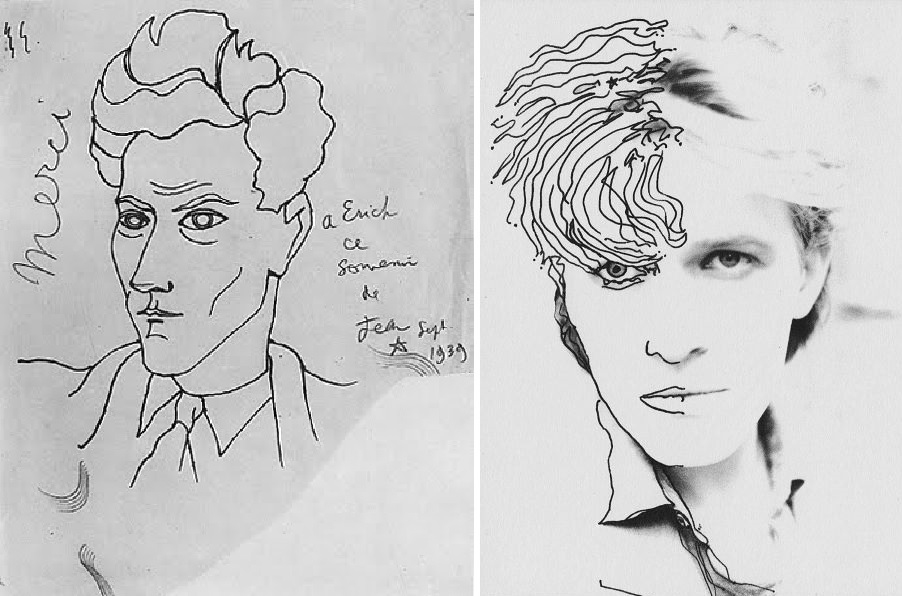
Cocteau, Sartre, and elsewhere on Brilliant Trees, Picasso and Radiguet, were all significant influences. For Sylvian, it was more than learning from great minds of the past through absorbing their work. ‘I felt a very close connection with Cocteau for a while. I really felt his presence,’ he said. Cocteau ‘made the invisible world tangible, and I’ve existed in that world (laughs).
‘I had existed in that world a long time but it was always denied by those around me as a delusion. So to find somebody writing about it and exploring it in film was like finding a friend. And to be honest, I think I’ve incorporated too many references in my work to other writers and artists. But the reason for doing so was that it was my community. I didn’t have one in the physical world. So I found like-minds through the work of others and I drew them into my work as a result. As a band of like-minded individuals, dead or alive, it didn’t matter. I sort of bonded with them.’ Interviewer: ‘Like soul brothers?’… ‘Yeah’. (2001)
‘Pulling Punches’
Richard Barbieri – synthesiser; Wayne Braithwaite – bass; Holger Czukay – dictaphone, french horn; Ronny Drayton – guitar; Mark Isham – trumpet; Steve Jansen – drums, synthesiser; David Sylvian – vocals, synthesiser, piano
Music and lyrics by David Sylvian.
Produced by David Sylvian and Steve Nye. From Brilliant Trees, Virgin, 1984
Recorded in London and Berlin, 1983/1984
Lyrics © copyright samadhisound publishing
Download links: ‘Pulling Punches’ (iTunes)
Physical media links: Brilliant Trees (Amazon – cd) (Amazon – vinyl reissue) (burningshed – vinyl reissue)
Sources and acknowledgements for artist quotes in this article can be found here. The full 40-minute film of the Hansa sessions can be seen on the samadhisound Vimeo channel here.
‘David has always been on some next type stuff. The video is well ?? but the audio is killin’! David has always been ahead of the curve. This was a wonderful time for me. He was a pure joy to work with. So open and clear.’ Ronny Drayton, 2010

More from Brilliant Trees & era:
The Ink in the Well
Red Guitar
Brilliant Trees
Forbidden Colours (version)
Nagarkot
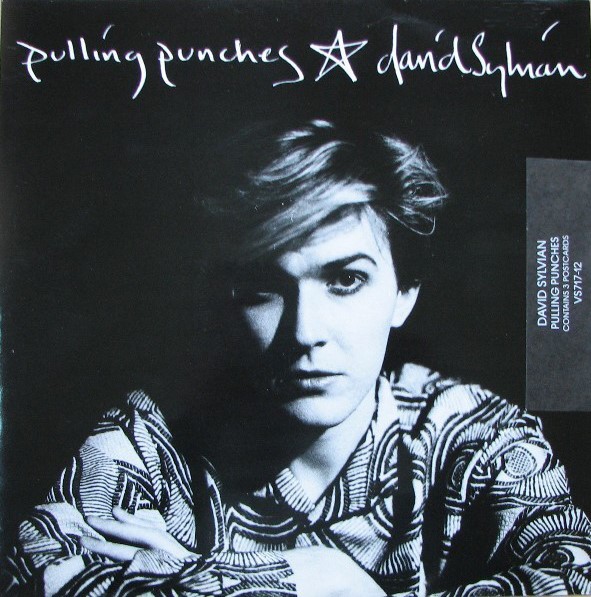
Another wonderful piece, thankyou for all your hard work. This is the first time i have seen the video for PP’s, i didn’t know one existed! To me BT’s, still sounds as fresh today as it did when released. So many albums from the 80’s have that 80’s feel about them, that doesn’t mean i dislike them in any way. But in BT’s and SOTB, Sylvian produced 2 timeless albums and that is an incredible achievement. He has also produced some timeless albums since then but right now i am looking at his 80’s period.
LikeLiked by 1 person
Thank you for this. I totally agree about the timeless nature of this music.
LikeLiked by 1 person
I actually think this is arguably the outstanding track on the album. It was so unexpected after hearing Red Guitar. Its a funk tour def force with an edginess and stark beauty to it. Brilliant Trees is my favorite DS album. It is almost perfect and a masterpiece. There is no weakness. Pulling Punches creates such dissonance but at the same time it hangs all together. The melody and the counterweaving beat immediately captures your attention and lyrically it is a stand out on an album filled with some of his strongest writing. This album came out at a time when my life changed dramatically and this record reminds me so much of that time. Brilliant Trees is such an interesting compelling album filled with strangeness, foreboding, emotion, positivity and soul searching. It was head and shoulders above what his contemporaries were doing at the time and he took music into another direction altogether.
LikeLiked by 2 people
Beautifully put, Michael. Thank you for sharing that.
LikeLiked by 1 person
Pulling Punches ‘an explosion of frustration’. Thank you, the VB. A beautifully written article, a synthesis of pop music history from an optimistic era, with fine art, philosophy and more besides. Your piece, together with the comments above, have reminded me of what else, besides melody and lyrics, with David Sylvian, that keeps me listening to some of those songs. It’s the punchy tempo, delivered not only by numerous gifted rhythm, guitar, keyboards, horns, sections, but the layered arrangements, the drive…It’s there in Pulling Punches, Cantonese Boy, The Art of Parties, so much going on, it’s sometimes slightly demonstrative, but always totally musical. Art of Parties is, in my view, slightly less melodic than the others, but it is one of the best examples of what I’m trying to identify, in this additional element. This is not only down to the writing, but the excellent musicians, many referred to in your article, VB. Not all David’s tracks contain those elements, but when they are there, it does quite a lot for my dopaminergic pathways! Brilliant Trees, is just a few paces away for me…It doesn’t matter that we’re all a lot older than we were (those of us who were around, that is) in 1983/84, we’re still around, and still enjoying…
LikeLiked by 2 people
David Sylvian tweeted today: ‘Ronny’s account of our day together in Berlin rings true. There’s musicians who’re born showmen, Ronny was one. When he realised he wasn’t just free to go wild but encouraged to do so, he didn’t hold back. It was an entire performance for those assembled. He was on fire.’ I’ve added this to the article.
LikeLiked by 1 person
I think that’s a french horn – Holger’s brass of choice – not a flugelhorn (K Wheeler’s instrument).
LikeLiked by 1 person
Thanks for pointing that out – mis-transcribed by me from the 12″ sleeve. You are absolutely right, of course, and I shall correct the text! Appreciated.
LikeLike
no harm no foul! always loved hearing a big Czukay blast of it within his own material! ~*~
LikeLiked by 1 person